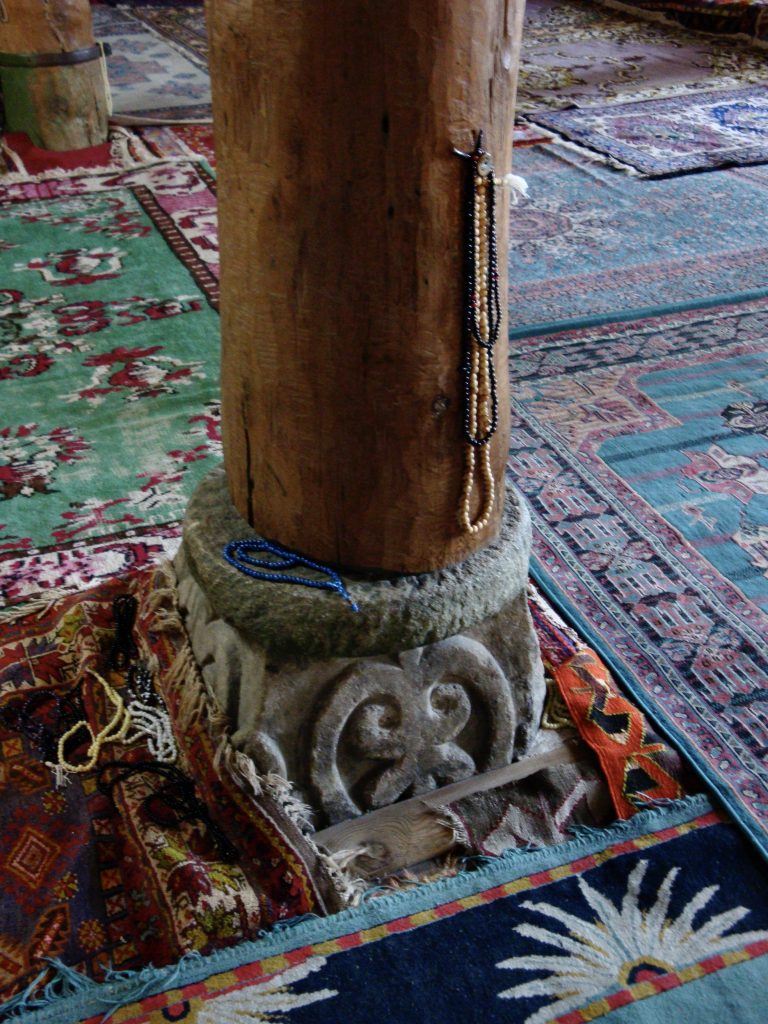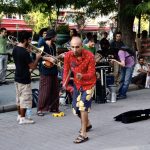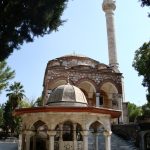“Pointed Castle” Population: 9,500
Old names: Abrostola (Roman), Justinianopolis (Byzantine)
Market day: Wednesday
Sivrihisar is a precious piece of the old Turkey, a place where it’s good just to relax and go with the flow, the kind of place which still hangs onto the generous and innocent hospitality of pre-tourism Anatolia. Here, when someone stops you in the street and asks somewhat bashfully if they can help, you can be sure that they have nothing to sell and that nobody is lurking nearby in hope of a commission.
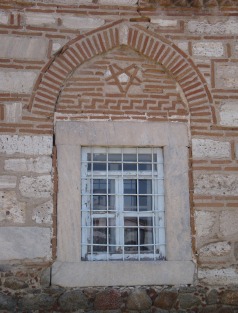 Decorative brickwork of Hoşkadem Cami
Decorative brickwork of Hoşkadem CamiImmediately east of Eskişehir, Sivrihisar gives the initial impression of a place that has turned its back on tourism. Buses from Ankara dump their passengers unceremoniously on the main road, and while the owners of the solitary town centre hotel could hardly be more helpful there’s no disguising the fact that their hostelry is way too basic for most tastes. The only alternative, designed with the needs of long-distance lorry drivers in mind, is more comfortable but stands remote from the main attractions beside a petrol station on the Ankara road.
But Sivirhisar is a real treasure, one of those increasingly rare towns that retains much of its original Ottoman townscape complete with crooked houses and ramshackle, defiantly non-chain shops. The craggy rocks that rise up sheer from the surrounding plain with the Yazıcıoğlu Kalesi built into them add to the town’s unexpected beauty, as do the myriad Selçuk and Ottoman relics that lurk in the back streets.
The importance of the town’s wonderful Ulu Cami was recognised in 2023 when it became a UNESCO world heritage site along with similar Anatolian “forest mosques’ – the Aslanhane Cami in Ankara, the Ulu Cami in Afyon, the Eşrefoğlu Cami in Beyşehir and the village mosque in Kasaba, near Kastamonu.
Backstory
Sivrihisar appears to have been founded as a military outpost on the road to Ankara by the Emperor Justinian (527-65). He was responsible for the castle whose ruins can still be seen on the summit of the rocks although it was completely rebuilt in Turkish times. Writing in 1842, the British traveller William Hamilton reported an incident in which a man named Yazıcıoğlu Bey set himself up as effective feudal overlord of Sivrihisar using the castle as a stronghold, hence its name. After nineteen years he was driven out and executed, suggesting that the castle continued into use into the 1820s.
Around town
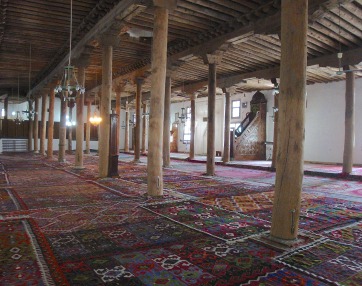 “Forest mosque” in Sivrihisar was one of last mosques to replace individual rugs with continuous carpetThe best place to start your exploration has to be the splendid Ulu Cami (Grand Mosque), built in 1275 for Eminiddin Mikail, a follower of the Mevlana.
“Forest mosque” in Sivrihisar was one of last mosques to replace individual rugs with continuous carpetThe best place to start your exploration has to be the splendid Ulu Cami (Grand Mosque), built in 1275 for Eminiddin Mikail, a follower of the Mevlana.
Aside from its soaring brick mosque, this is one of those secretive buildings that gives little away from the outside. How wonderful, then, to step inside and find a long hall of a mosque whose ceiling – – a forest of hewn tree trunks – – is held up by 67 wonderful wooden columns, most of them resting on marble stones obviously scavenged from local ruins, including two capitals pilfered from nearby Pessinus.
The mihrab wears a thick overcoat of paint but beneath it it’s possible to pick out the complex geometric designs of the Selçuks. The mimber is a masterpiece of Selçuk woodwork. As late as 2011 its floor was still covered with individual rugs although I fear that they have since been replaced.
Near the mosque is the cute little Alemşah Kümbeti, an Ilhanid work of 1327 with marvellous stone carving on the outside and inside.  Mihrab inside Alemşah Kümbeti
Mihrab inside Alemşah Kümbeti
From the Ulu Cami it’s just a short stroll to the old Yoğurt Pazarı (Yoghurt Market) where suddenly, like a butterfly emerging from a chrysalis, Sivrihisar starts to reveal its charms.
The market is a misshapen piece of land surrounding one of the two “camisız (mosque-less)” brick minarets arising from tall stone plinths which are a feature of the town. No one seems quite sure what became of the mosques (if indeed they ever existed). “An earthquake,” hazards one local, which hardly explains why the minarets would stand intact. “Pulled down in the past,” suggests another which sounds equally unlikely.
What is clear is that the minaret is surrounded by imposing Ottoman konaks (mansions) which are now being restored as the town tries to reinvent itself along the lines of Beypazarı, the small town near Ankara that has so successfully rebranded itself as a Safronbolu-lite.
The Sivrihisar mansions were constructed with a wooden frame which was filled in with patterned brickwork. Later on the bricks vanished behind painted plaster which is now being stripped away to reveal the original designs. Two of the finest examples stand apart from the market on the western side of town. The Zeyneller Konağı features a cross in its brickwork which might suggest that its owners were Christian. Then there’s the even more beautiful Sakarya Konağı, with, right beside it, the town’s pride and joy – the restored Zaimağa Konağı where Atatürk met with colleagues to discuss the progress of the Turkish War of Independence on 24 March 1922.
A visit to the Zaimağa Konağı offers a chance to eyeball the lifestyle of the comfortably off of the late 19th century. The woodwork may have been reconstructed but you get to peek inside the cupboards at the tiny spaces that used to serve as showers in the days when, understandably, regular trips to the local hamam (Turkish bath) would have been de rigueur. Larger cupboards were used to house bedding which was laboriously taken taken out and then stored away again every day at a time when the divans along the wall doubled up as beds. One especially intriguing feature of the house is a square cut out of the upstairs floor just above the front door. Such holes above gates in castles were cut to enable defenders to pour boiling oil down on their enemies. Here, however, the hole merely allowed those upstairs to see whether the visitor was a man or a woman before descending to greet them.
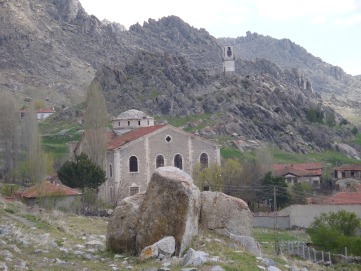 Armenian church in foreground, clocktower in backgroundA short walk away stand the remains of the enormous Surp Yerrortutyan (Holy Trinity) church built in 1881 on the site of a church dating back to 1650 for use by the Schismatic (Apostolic) Armenians, a group that had broken away from the Greek Orthodox Church after the Council of Chalcedon in 451. Towards the end of the 19th century there were about 300 such families living in Sivirihisar, according to the British traveller, William Hamilton. The front part of their church was later pressganged into service as a power station. Today it stands abandoned, although the dome has been restored.
Armenian church in foreground, clocktower in backgroundA short walk away stand the remains of the enormous Surp Yerrortutyan (Holy Trinity) church built in 1881 on the site of a church dating back to 1650 for use by the Schismatic (Apostolic) Armenians, a group that had broken away from the Greek Orthodox Church after the Council of Chalcedon in 451. Towards the end of the 19th century there were about 300 such families living in Sivirihisar, according to the British traveller, William Hamilton. The front part of their church was later pressganged into service as a power station. Today it stands abandoned, although the dome has been restored.
Sivirisar has plenty more unexpected delights up its sleeve. The Kurşunlu Cami, for example, on the eastern side of town dates back to 1492 and is a classic example of early Ottoman architecture. In front of it is a fountain whose pillars rest on old Roman capitals and whose back rests against an old Roman sarcophagus.
On the western side of town, past a creakily authentic old market-place which springs to life every Wednesday is the Aziz Mahmud Hüdayi Cami which dates back to 1591 but was redecorated in a frothy baroque style that recalls the Balyan mosques of İstanbul in 1894.
Nearby is the 13h-century Hoşkadem Cami with some wonderful carvings in its brickwork and pieces of old Roman masonry dotted about the graveyard.
In the foothills of the rocks you can hardly fail to spot the clocktower that dates back to 1899.
Less obvious but well worth climbing up to see are the remains of the Gavur Hamamı (Infidel Bathhouse), a Selçuk-era building apparently rebuilt in 1883. Standing in front of it the silence is so profound that it’s broken only by the curious clashing noise made by mating tortoises, the sharp drumming of a woodpecker and the frantic cackling of jackdaws.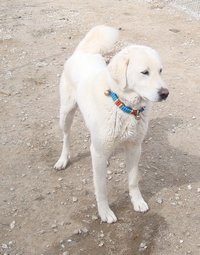
Finally, those with an interest in dogs might want to pay a visit to the Akbaş Çiftliği where akbaş (white-headed) sheepdogs, close cousins to the better known kangals (karabaş, black-headed), are bred – to find it look for the statue of a shepherd with his dogs and take the road beside it.
Sleeping
Nasreddin Hoca Oteli On the edge of the old town this ultra basic hotel has friendly owners in its favour but grungy fittings and only shared bathrooms catering for an almost entirely male clientele. Tel: 0222-711 4370
Şoförler Federasyonu Rooms at the Chauffeurs Federation hotel are spotless and well-equipped, if not luxurious. They’re across the road from a petrol station with a large self-service restaurant for breakfast and dinner. There’s lots of parking space but if you’re without your own wheels you’ll need a taxi just to get back into town. Tel: 0222-711 4893
Transport info
Hourly buses connect Sivirhisar town centre with Eskişehir. Buzlu buses from Ankara pass the outskirts of town.
Buses from Eskişehir to Ankara pass the junctions for Nasrettin Hoca and Yunus Emre. Without your own transport you should get out at the petrol station marked by the statue of the hoca and ask someone to call a taxi for you.
Day trip destinations

